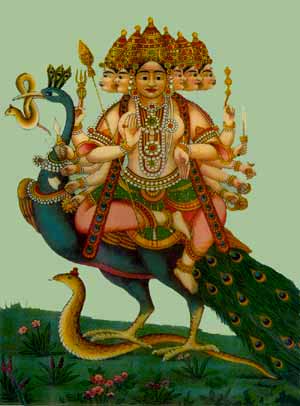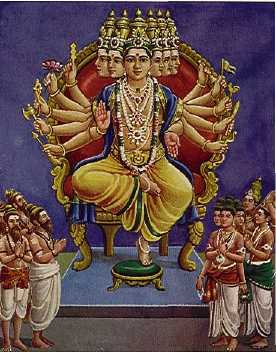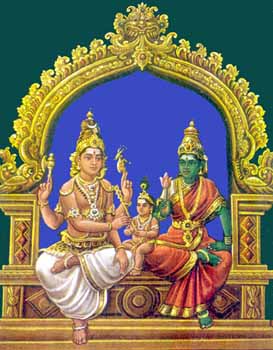
|
||||||||||
|
| ||||||||||
Skanda-Subrahmanya in Sanskrit Tradition
by Dr. S.S. JanakiThe religious history of Bhārata Varsa, now called India, has its origin from prehistoric times. The original name of Indian religion, namely, Sanātana Dharma, is significant and indicates its chief characteristics of eternality, continuity and variety. Foreigners have coined the name 'Hinduism' for this unique religion. Whatever be the name, the spirit of Indian religion and spiritual culture has been almost the same throughout Vedic, Vedantic, Epic and Puranic times. Its form however, has undergone remarkable changes. In the Vedic period cosmic powers were worshipped as divine manifestations. In subsequent times, the two major deities, Śiva and Visnu, their consorts, family, and incarnations, were and are still being adored externally and internally through yoga, meditation etc. But the fact remains that Indian religious culture satisfies during all times the yearnings and needs of persons endowed with differing capacity (adhikāra) for deeper experience and varying psychological nature (svabhāva). Kumāra is generally considered as the son of the divine parents Śiva and and Pārvatī. He is known from varied Sanskrit texts from the ancient to the present times under varied names like Kārttikeya, Visākha, Guha, Senāpati, Sanmukha and Śaravanabhava. Some of these like Kārttikeya (son of the Krttikā goddesses) and Saravanabhava (born in a thicket of reeds), clearly describe the god's personal details through their own etymology and simple legends. Amongst the god's names Skanda and Subrahmanya are crucial to understand the symbolism and evolution of the deity's concept and its worship (upāsanā) in diverse ways as suited to a range of devotees. In the present paper the references to Skanda and Subrahmanya as occuring in the ancient Sanskrit literature, which includes Yajur, Sāma and Atharva Vedas, Chāndogya Upanisads, Rāmāyana, Mahābhārata, and Skanda Purāna, are collected and critically studied. In the final analysis it is shown that this god was and is conceived and meditated upon at different levels, in his iconographical mūrti form (skala), in a form and formless state in the pāñcāyatana worship with distinct symbolism, as also at the pure absolute level with no attributes (nirguna) or parts (niskala). Firstly, varied information about Skanda in the selected texts is given under distinct categories and explained.
Skanda is a noun derived from the verbal root skand that carries some meanings like 'jumping', 'spurting'/'spilling'/'effusing', 'perishing', 'drying up', and 'gathering together'. Sandhānam skandanam caiva pācanam dāhanam tathā
Early Sanskrit texts like the Rāmāyana, Mahābhārata and Skanda Purāna bring out the appropriateness of the name Skanda given to Kumāra, while describing his birth and valorous deeds. Among the meanings of the root skand, that of 'spilling', especially of the semen of Śiva, recurs in the stories about the birth of Kumāra. There are of course, slight variantions in them. Three such anedcdotes about his birth can be seen now. Vālmīki's Rāmāyana. In Bāla Kānda (Sargas 36 and 37) of the Rāmāyana, sage Viśvāmitra recounts the details of Kumāra to Rāma and Lakshmana, in order to bring out the unique charm of the deity and his valorous deeds as a child. In sarga 36 it is said that Śiva and Pārvatī enjoyed sexual union for one hundred divine years. No child was born to them as was expected of such a marriage by the gods who suffered a lot by the misdeeds of the demons. Headed by Brahmā, the gods approached Śiva and Pārvatī and requested them to engage themselves in severe austerities with full control of sexual instincts for the benefit of the three worlds (verse 11).
Trailokyahitakāmārtham tejastejasi dhāraya While agreeing to do so, Śiva asked the gods, when by some chance, his instincts were stirred up, who would be able to receive and retain his powerful semen. As suggested by the gods, after some years Śiva discharged his seminal fluid on to the Mother Earth. The latter was able to carry and retain Śiva's lustre only due to it being carried to the entire earth by Agni the Fire-god. When Śiva's fiery lustre spread over the worlds, silvery mountains and a divine thicket of reeds (śaravana) appeared on earth. In that forest was born Kumāra.
Pārvatī was however disappointed at the gods not allowing her to hear the "fire of Śiva". Thereupon she cursed both the gods and Earth, that thenceforward the gods would not be able to impregnate their consorts, and that the Earth also would be enjoyed by many husbands. So saying Śiva and Pārvatī go to the Himalayas to perform severe penance. The first effort of the gods was thus unsuccessful due to the displeasure caused to Pārvatī. No god could impregnate his consort on account of Pārvatī's curse. Hence Brahmā suggested to Indra and others that Śiva's 'seminal lustre' held by Agni could be transmitted to the Gangā flowing in the divine regions (Ākāśa Gangā). Besides not being the consort of any divinity, Gangā, as arising from the Himalayan ranges, was the elder sister of Pārvatī. Hence Pārvatī would be quite delighted if Gangā would bear and retain 'Śiva's lustre' and deliver it as a son for the benefit of the three worlds (Sarga 37 verse 8). Accordingly, Śiva's tejas was transferred to Gangā by Agni with the help of Vāyu. She bore it with great difficulty and deposited it in the Himalayan range. At that time there was a brilliant glow all around. Bright dazzling metals like gold, silver and copper appeared. Kumāra was born in that atmosphere. Immediately Indra and other gods arranged for the six Krttikā stars, who represent a star cluster in the third mansion having Agni as its regent, to nurse the child with their milk. They did so in the form of nymphs. Concluding the birth-story of Kumāra, Vālmīki says that the gods called the child Skanda, being born from the spilling of Śiva's tejas through Agni (verse 27). Mahābhārata (Vana 183-4, Śalya 39) narrates the birth of Kumāra as the son of Agni and Svābhā. But the significance of his name 'Skanda' is explained (Vana 184.18; Salya 39.6) as in the Rāmāyana. The birth-story of Kumāra in the Skanda Purāna (chapters 25,26) is different. As narrated here, Śiva listens to the troubles of the gods created by the demons against them, and the necessity for Śiva procreating a son soon to overcome their problems. According to their wishes, Śiva took up a beautiful form with six faces and looked at Pārvatī lovingly. At that time, a dazzling lustre similar to numerous suns arose from the eye in his forehead. This was so, because Śiva is greatly self-controlled that his semen can have only an upward movement. Hence he is called Ūrdhva-retas. The six-faced lustre spread out in the whole world. People, not being able to put up with it, ran in all directions. At Śiva's suggestion, the Fire and Wind gods carry the lustre to a forest of reeds near Ganges, who united it with a lotus that was in a pond nearby. There a charming child with six faces and twelve arms was born. In the next moment the infant was transformed into a normal but extremely beautiful child (26.16-17). Again, when at the bidding of Visnu, the six Krttikās came near, the child again became sextuple in order to allow each of them to feed it with millk (tāsām anugrahārthāya sodhā mūrtir abhūt ksanāt). In another context it is said that when Pārvatī embraced the children, they all converged into one form. In this account there is the emission of the lustre of Śiva through his eye(s) in his forehead. We also have the appearance of Kumāra as a baby in six forms or their merger into a single personality as needed in the context. Hence both the meanings of the root skand, namely, 'emitting' and 'merging into one' are applicable here. II.v. In yet another context the Skanda Purāna (35.11) applies the third meaning of skand as 'drying' or 'scorching' (śosana). Does he not attack and scorch the power of his enemies in the three worlds and win over them? ākramya ca yato śkandaddhikramena jagattrayam
In section II, in the context of explaining the etymological significance of the term Skanda as applied to Kumāra, a few versions of his birth were noted. The variations in them are quite interesting and need to be critically studied and analysed. There are, for example, different persons like Śiva, Brahmā, Agni, Indra, Pārvatī, Svāhā, and Gangā who are considered as Kumāra's parents. Also, he is considered as one person, a person with six faces, one with six forms, or, as seen in II. iv., he is born as single and transformed into six different babies for being fed by the Krttikās, only to become single again when embraced by Pārvatī. In fact, the Mahābhārata (Śalya 41.85-7) refers to Kumāra's varied parentage and his being considered as one, two or four or even as hundred or thousand: kevidenam vyvasyanti pitāmtasutam vibhum
Having seen Kumāra in II. iv. as one or six in appearance, we can see now an account of him taking four forms on a special occasion, as narrated in the Mahābhārata (Śalya. 39). The story starts here, after the birth of Kumāra to Gangā., when Brhaspati performs the divine child's purificatory rites (jātakarma). Immediately thereafter, due to the grace of goddess Sarasvati, Dhanur Veda with its accessories of missiles (astra), weapons (śastra) etc. attend on the body. It became powerful, internally and externally (mahāyogabalānvitah). His parents eagerly approached the unique baby with great affection. As they all wanted to meet him at the same time, Kumāra took four similar and resplendent forms, (samarūpinah, bhāsvara-dehāh) and went to them with a spear in hand. Thus he approached and saluted Rudra as Skanda, Umā as Viśakha., Agni as Śākha, and Gangā as Naigameśa. It is to be noted that of these four, Skanda and Viśākha are well known as Kumāra's names. Dazed by the unique powers of Kumāra, the divinities requested Brahmā to anoint him as their commander-in-chief. Brahmā acceded to their wishes. As a mere child, Kumāra then performed miracles like killing powerful demons like Tāraka and Sūrapadma, and splitting the Krauñca mountain with his Śakti. Regarding Skanda and Visakha there is interesting information in some ancient texts. According to the Sāmavidhāna Brāhmana (I. 20. p. 59) Skanda is one of the deities to be propitiated with the chanting of specific Sāma Vedic hymns (like I.246, I.533 and I.565). iti dve esā skandasya samhitā, etām prayuñjan skandam prīnati The Vamśa Brāhmana is a minor treatise associated with the Sāma Veda. It is concerned with the deities, the Samhitās or their musical renderings of specific hymns among them, and the long line of sages through which the Sāma Veda has come down. The introductory part of Vamśa Brāhmana entitled Sāmatarpana enumerates the list of deities, to whom water-libations are to be offered. Amongst them figure the twin-gods Skanda-Viśākhau, (p. 217, Vamśa Brāhmana). The Atharva Pariśistas are a collection/compilation delating with elaborate ritualistic and procedures details of important Atharva rites as related to many deities. The 20th section in this text is titled Skandayāga or Dhūrtakalpa, 'dhūrta' (literally, 'rogue') being a synonym of Skanda. This vrata is to be observed on the sixth day after new moon in the months of Phālguna (February-March), Āsādha (June-July) and Kārtika (October-November). The worship of Skanda on the occasion follows the usual routine of invocation (āvāhana), invitation (āhvāna), his entry, offering of pādya to wash his feet, worship with flowers, followed by the cordialities (upacāras), naivedya, offerings in fire, worship and consecration of the thread (pratisara), and tying the same, and allowing the god to leave the place (visarjana). Skanda is called by his other names including Viśākha in the course of the varied worship. In one context (20.6.4) his diverse parentage as the son of Agni, Krttikās, Paśupati, Rudra and Indra is mentioned. āgneyam krttikāputiamaindram kecidadhīyate /
Importantly in 20.2.9, in the context of inviting Skanda to be present for the worship, Skanda is referred to as a 'brother of Viśākha'. bhrātra viśakhena ca viśvarūpa
The grammatical texts of Pānini and Patañjali also refer to Skanda and Viśākha as twin gods, worshipped in images, under the sūtra "Devatādvandve ca" (Pānini VI. 3. 26). Patañjali (Mahābhāsya on VI. 3. 26) clarifies that these two gods were not offered libations together in the Vedic age: Hence it is clear that the consideration of Skanda and Viśākha as twin gods was only a post-vedic concept. But in the earlier times they may have been considered as brothers. It is interesting to note that Valmiki in his Rāmāyana, compares Rāmā and Laksmana to Skanda-Kumāra, the twin sons of Agni, in youthful charm and prowess (Kumārāviva Pāvakī). It is clear from these references that Viśākha is not a mere synonym of Skanda because he was born in the particular star (Viśākhāsu jātah). But in some later Vedic texts and in the Rāmāyana they are considered as brothers or even twins. As seen above in sections II to IV, the Vedic, Epic and Puranic literature use the term 'Skanda' meaningfully. True to the different etymologies of the term, the texts provide information of the god like his birth, parentage, concept and rituals. In a retrospective such details are:
The term Skanda also occurs along with names of his parents, as Somāskanda representing the triune aspects of Śiva, Pārvatī and Skanda. It is the most
The signification of Somāskanda can be understood in the light of Śiva's explanation of Kumāra's concept of Pārvatī in Skanda Purāna (Sambhava, 35.5-8). Accordingly, the love of the two streams of grace, namely, Śiva and Śakti, unite in Subrahmanya. He represents the eternal union of the Supreme Śiva and Pārvatī of Inexhaustible Energy, that is comparable to the blend of sound and sense. Kumāra is 'six-faced' on account of his representing both Śiva as Sadāsiva with 'five faces' (namely Sadyojāta, Tatpuruśa, Vāmadeva, Aghora and Īśāna) and the many faceted Śakti endowed with one face: Śivo ham niskalah pūrnaś śaktis tvamanapāyinī /
Thus by invoking the grace of Kumāra, one invokes the grace of Śiva and Śakti. All these ideas are signified through the form of Somāskanda, in which Skanda is placed between his parents. In every temple of Śiva we have these images. It is noteworthy that in Kāñci near Chennai, temples dedicated to these three gods are themselves situated in the same order - the Kumāra Kośta temple of Skanda is located in between the temples of Ekāmranātha and Kāmākshī. While the term Skanda and the legends based on its etymology highlight mostly the personal details of the deity, the term Subrahmanya is loaded with symbolism at the supreme and absolute levels. This signification is quite in keeping with the two components of the term, namely, the prefix su- (meaning beauty, excellence, joy etc.) and its qualifying noun brahmanya that is related to Vedas, Supreme knowledge, Absolute Reality etc. A few puranic legends and the liturgic formula Subrahmanyom and its many-sided symbolism support the prime status given to Subrahmanya as being on part with the Supreme Śiva. In a few versions he is even considered higher than his father. The Skanda Purāna (Sambhava., chaps. 34, 35) highlights the supernal qualities of Subrahmanya in the words of Śiva himself. In this context (34.28-30) it is said that both these gods signify the mystical syllable Om. These are evident in the two formulas containing the names of the two gods followed by Pranava. Moreover, the son secretively explains the same to his father Śiva also. arthamāha sma senānīh pranavasya rahasyatha /
In more than one context (Sambhava 35,20,26-7) the Purāna refers to Śiva's glorification of his son. Herein Śiva says "At the level beyond formlessness (Niskala) my son represents the Absolute Truth, Consciousness and Joy (Saccidānanda). He is the importable Supreme Lustre (Param Jyotih), before which the sun, moon, and stars are dulled". It is also said that while Śiva is the Lord of divinities and of supreme knowledge, his son is their leader in yet a higher degree. Herein a novel derivation of Subrahmanya as sutrām brahmanyah is given. In the midst of myths and legends, one is constantly reminded of Subrahmanya as the embodiment of BrahmĀ Jñāna, as the expounder of the meaning of Om, and as the upholder and lord of Vedic way of life and rites. 'Subrahmanyom', with the repetition of pranava three items for special reverence ('ādarārtham' as Sāyana explains) in many Vedic sacrifices and rituals, is intended not only for Śiva's son but also for any divinity like Indra and Agni. So much so, that this mantra is to be found in many Vedic texts, especially the Brāhmanas. In conclusion it can be seen that Skanda/Subrahmanya is a federal deity and an integrator among the divinities. He is endowed with the essential of all divinities. Svāmi is the most common word for 'God' in India. It is significant that 'Svāmi' is primarily the name of Subrahmanya alone. In the lexicons like those by Amara Simha, Svāmi occurs as a name of Kumāra. Other divinities have, so to say, borrowed the name from Kumāra. Skanda is the son of Śiva and Śakti, younger brother of Vināyaka, son-in-law of Mahāvishnu, and is identified with the rising sun. By worshipping Kumāra we can be the recipient of the bounties conferred by all the other gods. Dr. (Miss) S.S. Janaki (M.A., M.Litt and Ph.D. in Sanskrit from Madras University, D.Phil. from Oxford) was former Director of Kuppuswami Sastri Research Institute, Chennai. The author of some 40 monographs and 150 research articles, she received the President's Award for Sanskrit in 1992. Dr. S.S. Janaki was one of Tamil Nadu's most distinguished Sanskrit scholars until her passing in 1999. This was among the very last articles of her long career in Sanskrit research and teaching. See also these related research articles about the cult of Skanda-Kumara in Sanskrit sources:
Index of research articles on Skanda-Murukan |


